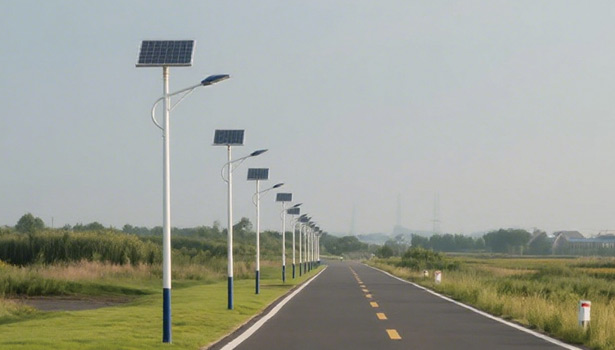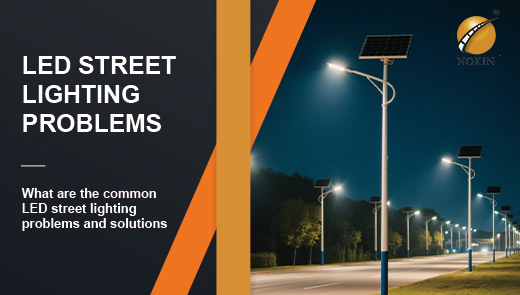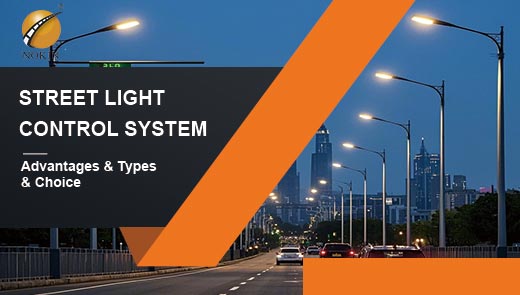What are the common LED street lighting problems and solutions?
LED street lights have become the core choice in the field of road lighting due to their significant advantages of energy saving, high efficiency, long life and fast response, etc. In the current situation of urban infrastructure construction, LED street lights have become the core choice in the field of road lighting due to their significant advantages of energy saving, high efficiency, long life and fast response. However, in the actual operation and maintenance process, LED street lights inevitably face all kinds of problems. In-depth analysis of these common problems, and explore scientific and effective solutions to ensure the stable operation of the urban lighting system, to enhance the quality of public services is of great significance.

Why do LED street lights flicker?
Root causes of flicker caused by the driving power supply
The driving power supply for LED street lights usually adopts the constant current power supply mode. Its working principle is that, when the internal resistance of the LED lamp beads due to temperature, use of time and other factors change, the constant current power supply will dynamically adjust the output voltage, so as to ensure that the current through the lamp beads always remain constant. However, there is a limit to this adjustment, each constant current power supply has a specific output voltage range. Once the LED lamp bead internal resistance changes are too large, resulting in the power supply output voltage exceeds the range, the power supply will trigger the protection mechanism, into the repeated on and off state, and ultimately manifested in the street lamps flicker frequently. This flicker not only affects the lighting effect, but also accelerates the aging of LED beads and power supply, shortening their service life.
Flickering phenomenon caused by mismatch of LED beads
Standard 1W LED beads, the current range of 80 - 300mA and voltage range of 3.0 - 3.4V during normal operation. If the selected lamp bead chip power is insufficient, even under normal driving current, but also can not work stably, resulting in frequent flickering of the light source, which is manifested in the brightness of the regular alternation of light and dark. When the drive power output current is too high, beyond the lamp bead capacity, will cause irreversible damage to the lamp beads, part of the lamp beads light up, part of the lamp beads off, long-term in this state will accelerate the aging of the lamp beads.
|
LED Parameter |
Normal Range |
Abnormal Behavior |
Failure Impact |
|
Current |
80 - 300 mA |
Some LED do not light up when current is too high |
Accelerates LED aging, reduces overall lighting performance |
|
Voltage |
3.0 - 3.4 V |
Insufficient power causes frequent flickering |
Affects lighting continuity, reduces visual experience |
Flickering problems caused by waterproof defects
In the complex outdoor environment, good waterproof performance is the key to ensure the normal operation of LED street lights. If the waterproof measures are not in place, rainwater, moisture, etc. may penetrate into the interior of the lamps. Once the lamp bead or power supply is eroded by water, its electrical performance will be seriously affected, which may lead to short-circuit or leakage, thus triggering the street light flicker. If not handled in a timely manner, this flicker caused by waterproofing problems, may also lead to more serious failures, and even bring potential safety hazards.
Flicker fault investigation and solution strategy
When the LED street light flickers, maintenance personnel need to gradually troubleshoot. First of all, you can replace the drive power supply and lamp beads to determine the location of the fault: replace the drive power supply if the street light returns to normal, the original drive power problem; if still flickering, and then replace the lamp beads to determine whether the failure; if the two alone can not be replaced to solve the problem, it is likely that there are faults in both, need to be replaced at the same time.
For the closure of the case is still flashing, usually related to the line, you need to focus on checking the switch control zero line, if the zero line is not connected properly or there is a leakage, will lead to street lights after the closure of the weak current still passes, this time you need a professional electrician to carefully investigate the repair. If there is no problem with the line check, it may be the LED street light itself produces self-induced current, you can block the current path by connecting a relay in series in the circuit to eliminate the flicker phenomenon.

Why do the LED street lights not work?
Lights out due to unstable voltage
The voltage of the city power grid fluctuates due to factors such as power peaks, line faults, etc. When the voltage exceeds the LED street light's adaptability, the LED street light will not work. When the voltage exceeds the adaptable range of LED street lights, the driving power of street lights will automatically enter into a protective state and stop working, resulting in irregular extinguishing phenomenon. Generally speaking, after the voltage is stabilized, most street lights can restart automatically. However, frequent and large voltage fluctuations will adversely affect the service life of street lights.
The key points of single-side street lamps do not light up
When single-side street lamps do not light up, you need to check whether the power switch on that side is working normally, to see whether it is tripped, whether the contact is good, and whether there is excessive current or power leakage phenomenon. At the same time, the control system is also the focus of investigation, to check whether the signal line is broken, disconnected, and whether the control settings are correct, such as whether there is a single side of the street lamp control program error or improper parameter settings.
Handling of multiple street lights not lit at the end of the line
If multiple street lights at the end of the line are not lit at the same time, it is likely that the cable has burned or cut off the problem. At this time, you need to use professional cable testing equipment for testing, once the cable is determined to be damaged, to be replaced in a timely manner. Replacement of the cable to choose the appropriate specifications to ensure that the connection is firm, and do a good job of waterproofing and insulation.
Single street light does not light up the overhaul process
For a single street light that does not light up, first use a multimeter and other tools to measure the power supply output voltage and current to determine whether the power supply is working properly. If the power supply output is abnormal, further check whether the internal components of the power supply, such as fuses, capacitors, etc. are damaged. After confirming that the power supply is normal, a detailed inspection of the lamp head assembly, check whether the heat sink, LED chip, power driver and other components are faulty, such as poor heat dissipation, LED chip quality is poor, power driver failure, etc., to find out the failure point after repair or replacement.
How to reduce the glare of LED street lights?
Hazard of glare and principle of formation
Glare refers to the strong and harsh light emitted by the light source, which can cause interference to the visual system of the human eye. When the human eye is exposed to glare, the retina is overstimulated, resulting in blurred vision and reduced contrast, which affects the clear observation of the surrounding environment. In road lighting scenarios, glare reduces the clarity of the driver's vision and increases the risk of traffic accidents; in daily life, it also affects the experience of reading, watching TV and other activities.
Reducing brightness to reduce glare
Take the example of a parking lot outside a supermarket, where the required illumination is usually 75lux. Known as a single parking space area of 15 square meters, according to the luminous flux = illumination × area of the formula, can be calculated for each parking space required luminous flux of 1125LM. most of the current LED street lighting efficiency of about 130LM / W, taking into account the line loss and other factors, theoretically, 50W street lamps can meet the demand, but the actual parking lot is often installed more than 100W LED lamps, which may lead to glare problems. Problems. In this case, lower power lamps can be selected to ensure basic lighting while reducing glare.

Optimize beam direction by sdding a lampshade
By adding a lampshade to an LED streetlight, the light can be redistributed to make the beam more directional. For example, on roads close to residential buildings, adding a lampshade on the back of the street light can block the light from shining backward, avoiding the light from entering the residential buildings and affecting the residents' rest, and at the same time, make the light more concentrated on the road surface, reducing light pollution and glare.
How to Improve the uniformity of LED street lights?
Lighting uniformity
Lighting Uniformity is a key indicator for measuring the quality of road lighting, which is quantitatively assessed by the overall uniformity (U₀) and longitudinal uniformity (U₁). U₀ is the ratio of the road's minimum illuminance to the average illuminance, reflecting the entire road surface. U₀ is the ratio of the minimum illuminance to the average illuminance of the road, reflecting the average uniformity of the entire road lighting area; U₁ is the ratio of the minimum illuminance to the maximum illuminance, which measures the uniformity of illumination in the longitudinal direction of the road. Good lighting uniformity helps to enhance road safety, reduce dark areas and glare so that drivers and pedestrians can observe the road conditions more clearly, and at the same time improve energy utilization efficiency and avoid energy waste.
Optimize the layout of street light poles
Reasonable planning of the spacing of street light poles and maintaining an even distribution can effectively avoid dark areas on roads. At the same time, according to the width of the road and the required illumination, flexible adjustment of street light pole height. For example, wider roads need to appropriately increase the height of the pole to ensure light coverage; narrower roads can reduce the height of the pole, so that the light is more focused on the road surface.
Adoption of asymmetric optics
Asymmetric optics can be used to target light to the area that needs to be illuminated according to the actual needs of the road. Compared with the traditional symmetrical optics, the asymmetrical beam angle design can make the light more concentrated in the middle of the road, reduce the scattering to the two sides, and realize the even distribution of light on the road, avoiding over-illumination and dark areas.
Choose the right lamps
Choose LED lamps with lighting efficiency ≥130lm/W, which can provide higher luminous flux under the same power and realize better lighting coverage. At the same time, controlling the color temperature in the 4000K - 5000K range provides the best road visibility, while too low or too high a color temperature will affect the lighting effect and visual comfort.
Intelligent lighting control
With the help of adaptive dimming technology, the street light brightness is adjusted in real time according to the changes in traffic flow, keeping the brightness high during heavy traffic and lowering the brightness at night when traffic flow is low to save energy. Motion sensors are installed in the pedestrian crossing area, triggering the street lights to increase brightness when pedestrians are detected, enhancing pedestrian crossing safety, realizing flexible and intelligent lighting control, and improving lighting uniformity.

How to solve the heat dissipation problem of LED street lights?
The Importance of heat dissipation for LED street lights
When LED street lights are working, the LED chips will generate a lot of heat. If the heat can not be emitted in time, it will cause the chip temperature to continue to rise, which will reduce the luminous efficiency, accelerate the aging of the chip, and lead to the phenomenon of light degradation. Good heat dissipation performance is the key to ensure stable operation, extend service life and maintain lighting quality of LED street lights.
Common heat dissipation methods and characteristics
In the external heat sink heat dissipation methods, the common ones are aluminum shell and cooling fan. Aluminum shell has good thermal conductivity and can quickly transfer the heat generated by the LED chip to the external environment, while the cooling fan accelerates the air flow by forced convection to take away the heat from the surface of the aluminum shell, thus reducing the internal temperature of the LED street light. However, the aluminum shell is electrically conductive and requires attention to electrical safety in the process of use, and is only suitable for relatively insulated environments. Moreover, the cooling fan may fail during long-term operation, and requires regular maintenance and replacement.
Thermally conductive silicone is currently the most widely used thermal material. It is a high-performance thermally conductive compound that does not cure and can maintain good flexibility and plasticity for a long time, making it easy to use in different shapes of heat dissipation structures. At the same time, it does not have electrical conductivity, can effectively avoid the occurrence of short-circuit and other electrical failures, improve the safety of LED street lights. In addition, the thermal conductive silicone has excellent bonding properties and high thermal conductivity, can be closely filled between the LED chip and the heat sink, to ensure the efficient transfer of heat, and its relatively low cost, can effectively solve the heat dissipation problem at the same time, reduce the production cost of LED street lights.
Soft ceramic thermal paint is a new type of thermal material, which can be sprayed on the outside of the LED street light housing. This kind of paint has wide applicability and can be applied to various shapes and structures of heat dissipation surfaces, and can be blended into various colors according to actual needs. The soft ceramic thermal paint contains a large number of very dense heat-conducting particles, which are able to fully contact with the air and evaporate the heat from the surface of the lamp housing over a large area, thus effectively reducing the temperature of the LED street lamp housing. However, compared with other heat dissipation methods, the cost of this method is relatively high, and the spraying process requirements are also high.
For high-power LED street lamps, due to the greater heat generation, a single heat dissipation method is often difficult to meet the heat dissipation needs. Therefore, in practical applications, it is usually necessary to comprehensively use a variety of heat dissipation methods to form a combination of heat dissipation solutions to ensure that the LED street lamps can maintain good heat dissipation performance under various operating conditions.
LED street lights occupy an important position in urban lighting, but in practical applications, they face many problems such as flickering, non-functioning, glare, uneven illumination, poor heat dissipation, etc. By understanding the causes of these problems, we can realize that LED street lights can be used in a variety of ways. Through in-depth understanding of the causes of these problems, and targeted to take scientific and effective solutions, can significantly improve the performance and service life of LED street lights. With the continuous progress of technology, the future of LED street light system will move towards a more intelligent and efficient direction, bringing better quality solutions for urban lighting, and continuing to create a safe, comfortable and energy-saving night environment for people.




